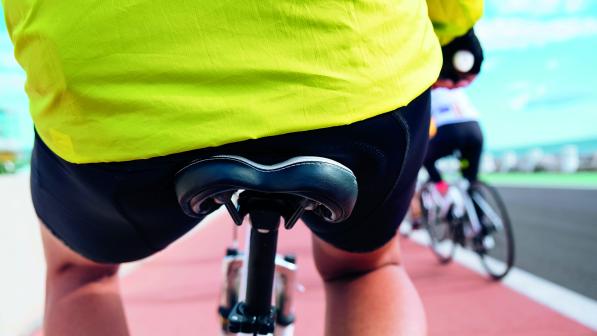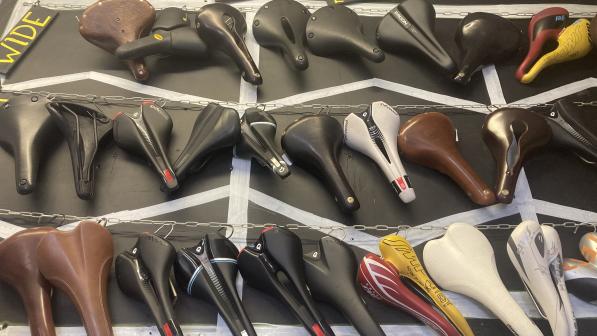Boy stuff: cycling, the prostate and erectile dysfunction

Prostate anatomy and problems in cyclists
A healthy human prostate is classically said to be slightly larger than a walnut. It surrounds the urethra just below the urinary bladder.
The prostate can enlarge to the point where urination becomes difficult. Symptoms include needing to urinate often (frequency) or taking a while to get started (hesitancy). If the prostate grows too large, it may constrict the urethra and impede the flow of urine, making urination difficult and painful and, in extreme cases, completely impossible.
Prostate problems and benign prostate (BPH) enlargement affect almost 50% of men over the age of 50. As many as 90% of men in their eighties may have some symptoms of BPH.
Prostate cancer is a common cancer in men. However, there does not appear to be any evidence in the literature that there is any link between cycling, prostate enlargement or prostate cancer.
There is weak evidence that trauma from bicycle riding can irritate the prostate and could exacerbate, and perhaps lead, to prostatitis (inflammation of the prostate) or chronic pelvic pain syndrome. Only a small number of riders get prostatitis from riding their bikes. Some evidence suggests than men should consider avoiding cycling during episodes of prostatitis (inflammation) or chronic pelvic pain syndrome.
If you are having prostate symptoms, visit your doctor or practice nurse.
It is known that cycling may transiently increase a man’s prostate specific antigen (PSA) level. PSA levels are often used as a key test of possible prostate problems, so men who are due to have a prostate test should avoid significant levels of cycling beforehand to avoid a possible false reading.
In experimental studies, cycling causes an average 9.5% increase in PSA in healthy male cyclists greater than 50 years old, when measured within 5 minutes post-cycling. Based on the research published to date, it is suggested that a 24-48 hour period of abstinence from cycling and ejaculation before a PSA test will help avoid spurious results.
The main issue in regard to cycling and prostate problems is to find ways of reducing pressure on the perineum, or groin area, as the prostate is located just below the bladder and in front of the rectum. This can be done in a number of ways, including wearing padded shorts, regularly standing on the pedals and changing the adjustment and position of the saddle.
Your saddle choice also makes a difference. The classical study in the British Journal of Urology in 2006 showed that a grooved seat allows better preservation of the seat-symphysis space than a standard seat, but the rider’s position is more important for preserving the seat-symphysis space (and reducing compression) than is seat design alone.
Any factors which influence the seat-symphysis space (including an individual’s anatomy, seat design and rider position) can increase the potential for penile hypoxia and erectile dysfunction/perineal numbness.
It seems sensible to use a saddle which aims to reduce pressure on the perineum. These kinds of saddles fall into several types of groups, all aim to reduce pressure on the perineum or groin area:
- Grooves and holes cut out
- Holes cut out and a cutaway at the back
- ‘Split saddles’ which have two sections and no central area
- Noseless saddles
Saddles with holes cut out of them may increase pressure inadvertently or pinch. Many saddle manufactures today make saddles with grooves, cut out holes and cutaways. As there are so many numerous designs, there is no correct answer, and the most expensive saddle is not the best. It's a matter of individual suitability and trial and error, so we are not going to endorse any particular saddle type.
Erectile dysfunction in male cyclists
Erectile dysfunction (ED) is defined as the inability to achieve and maintain a penile erection adequate for satisfactory sexual intercourse. Erectile dysfunction may have psychogenic causes (all relevant physiological and neurovascular pathways are intact, but a psychological impairment is present); or organic causes (a hormonal, neurovascular, or anatomical risk factor causes erectile dysfunction).
However, in most patients both factors probably contribute to the failure to achieve an adequate erection.
In cyclists, a population-based study indicated that bicycle riding for more than three hours a week was an independent risk factor for mild to moderate erectile dysfunction. The possible cause relates to compression of the pudendal nerve and arteries while cycling.
In a recent review there was thought to be a significant relationship between cycling-induced perineal compression leading to vascular, endothelial and neurogenic dysfunction in men and the development of ED. Research on female bicyclists is very limited but indicates the same impairment as in male bicyclists.
Preventative measures (including use of a properly fitted bicycle, a riding style with a suitable seat position and an appropriate bicycle seat) can help prevent impairment of erectile function. Some people say that there is less erectile dysfunction in cyclists as they are physically fitter – which may be true.
Additional comment – Chris Oliver comments on Can Bike Riding Up Prostate Cancer Risk? HealthDay 18/07/2014
Bibliography
- Prostate Scotland
- Prostate and Bicycle Seats. Livestrong
- Erectile Dysfunction. British Medical Journal. 2014;348:g129 Editorial
- Bicycle riding and erectile dysfunction: a review. J Sex Medicine. 2010 Jul;7(7):2346-58
- Long Distance Bicycle Riding Causes Prostate-Specific Antigen to Increase in Men Aged 50 Years and Over. PLOS One. Feb 13, 2013
- Digital three-dimensional modelling of the male pelvis and bicycle seats: impact of rider position and seat design on potential penile hypoxia and erectile dysfunction. British Journal Urology. 2007 Jan: 99(1):135-140


